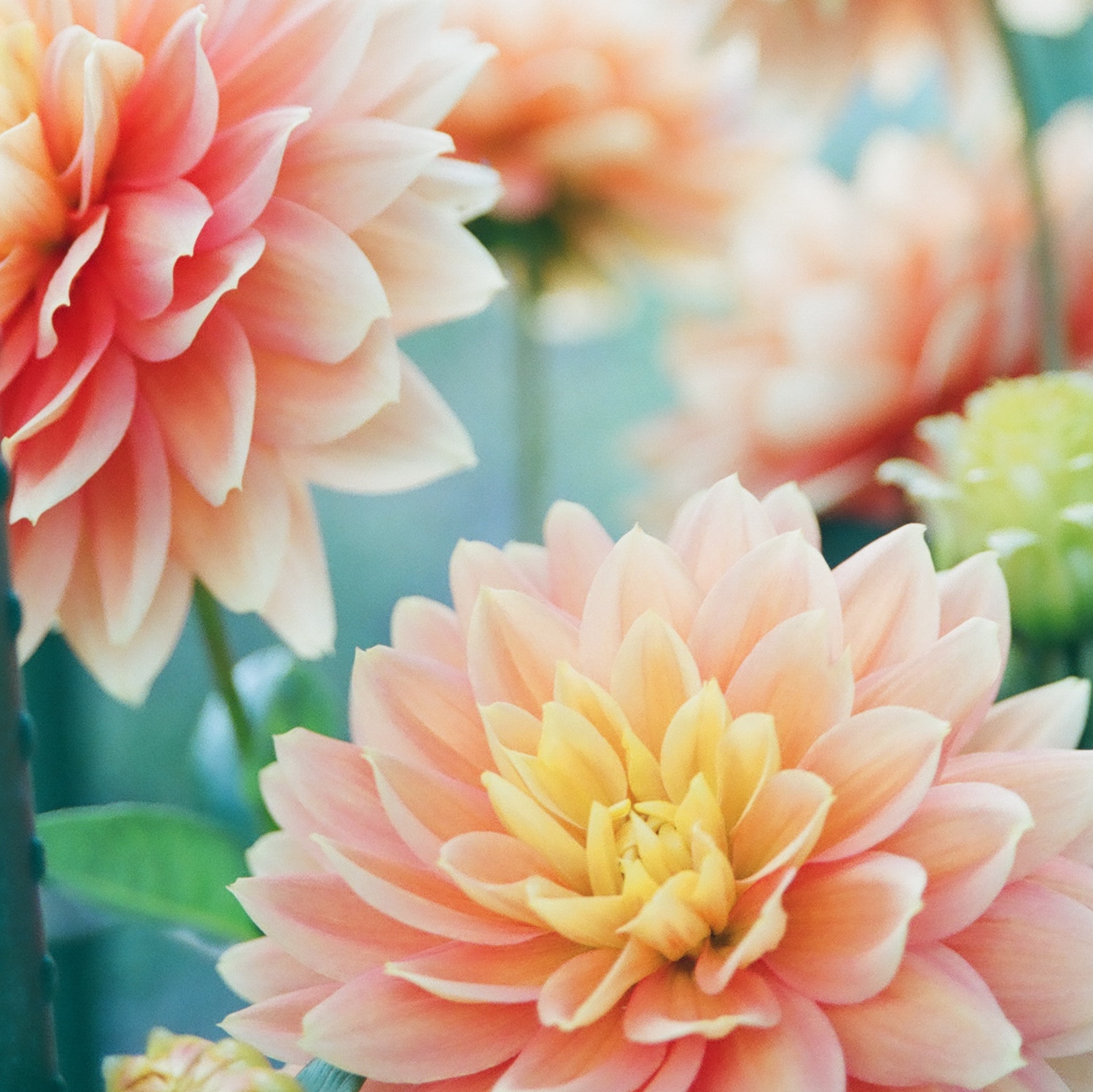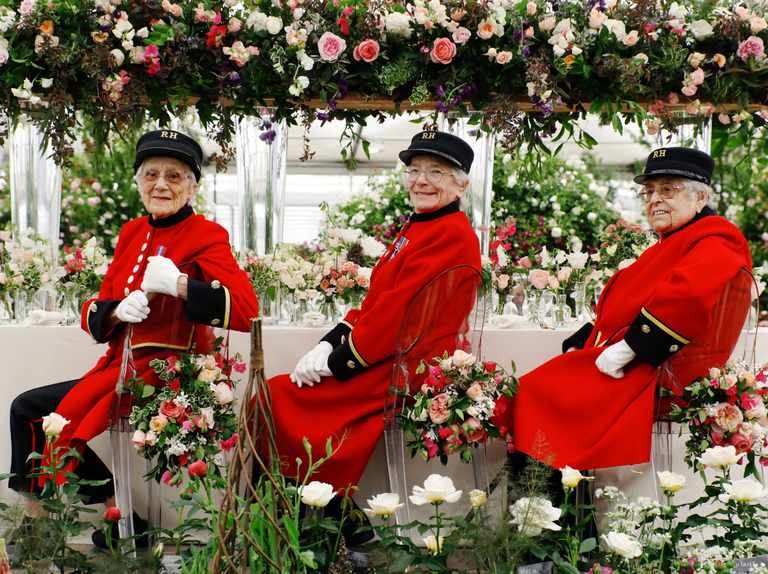FHB Highlight: «Flower Shows»
ELENA DÍAZ-GÁLVEZ PÉREZ DEL PUERTO
Mª TERESA VIDAL VIDAL
May 2021
BRITISH FLOWER SHOWS
ORIGINS OF THE FLOWER SHOWS
The flower show date its origins back to the seventeenth and eighteenth centuries where they flourished from the basis of the competitions put on by English florists’ societies. Some records of florists’ feasts around the country can be found as early as the 1630s although they were not very well documented until the beginning of the eighteenth century when local newspapers started reporting about them. In that period, the word “florist” was referred to an amateur grower of flowers, especially the ones that tried to produce new varieties. Florists’ societies organised their competitions in public houses and often they awarded the prizes at a dinner that followed the competition (hence the ‘florists’ feasts’).
The Horticultural Society (later the London Horticultural Society) was established by seven founders in 1804. Their members met at their rooms in Regent Street and brought plants for exhibition and discussion. They held its first show in 1827 in their garden in Chiswick.
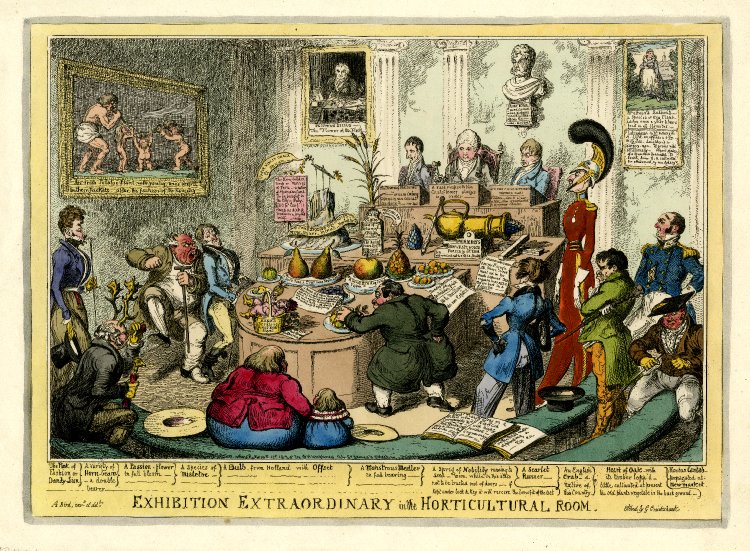
The British Museum © Trustees of the British Museum
Around the same time Horticultural societies began to appear on the other side of the Atlantic. The Pennsylvania Horticultural Society was founded in 1827 and the nation’s first flower show was held in Philadelphia in 1829 showcasing many exotic and native plants. Today it is considered the largest indoor flower show of the world. The Massachusetts Horticultural Society was founded in 1829, and immediately upon incorporation, the Society began weekly exhibits of locally grown produce, flowers, and horticultural techniques to teach the public about the newest innovations and cultivars.
Back in Britain, in 1832, the Horticultural Society’s rival Metropolitan Society of Florists and Amateurs was founded, becoming perhaps the most prominent among a number of organizations that tried to extend the traditional range of flower shows. As a result of the rivalry among the two institutions bigger and more numerous competitions started to be established. By the 1840s the Royal Botanic Society began to stage flower shows in the Inner Circle of Regent’s Park as also did The Crystal Palace Company in 1855 in their own grounds.
In 1861 the London Horticultural Society developed a new garden in South Kensington as their garden in Chiswick, not accessible by train at the time, had declined numbers of visitors. On that same year it became the Royal Horticultural Society when Queen Victoria became its first Royal Patron after Prince Albert, the president at that time, arranged a new charter. The first RHS Great Spring Show was held at the Society’s new garden in Kensington in May 1862.
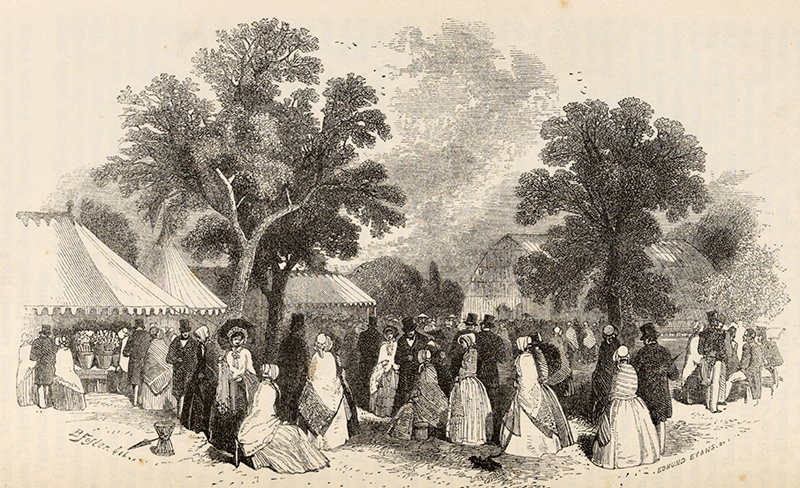
All those shows gained popularity and were very well attended despite the expensive entry fees. By the same time a gardening press had developed in England and the shows were widely reported. The Gardener’s Magazine reported a description that could apply to the Chelsea Flower Show of the 21st century.
‘The principal part of the English aristocracy is present, and mix indiscriminately with the tradesman, the mechanic and the gardener’
Gardener’s Magazine
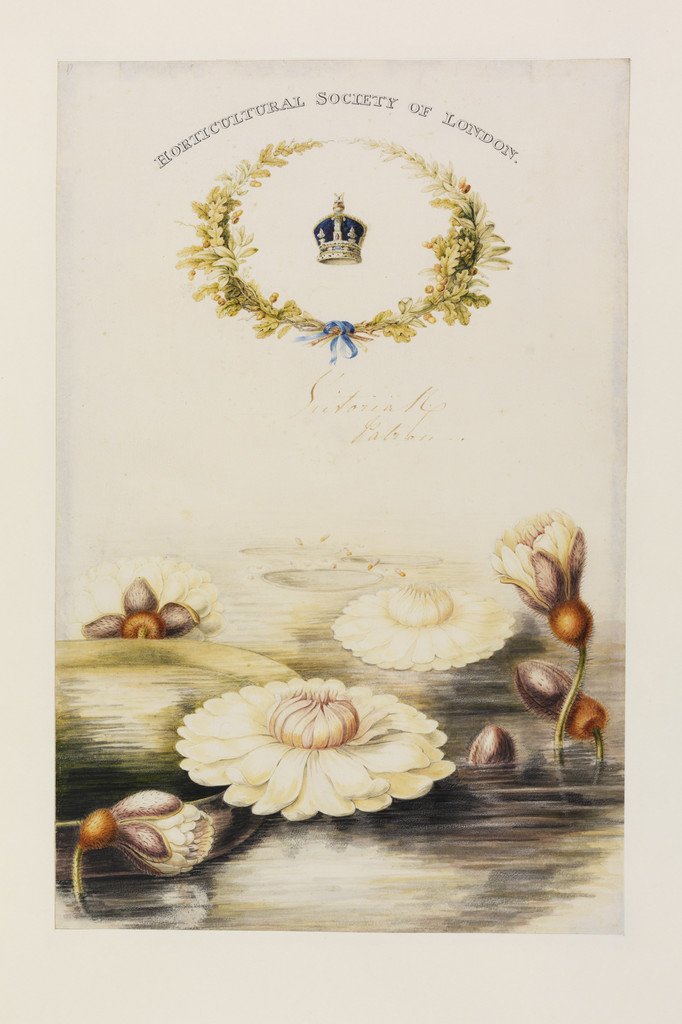
Of all those organizations that planted the seeds of the Flower Show as we know it, many have disappeared. The Metropolitan Society collapsed in the 1840s, the Crystal Palace Company eventually abandoned its flower shows and became bankrupt in 1911 and the Royal Botanic Society was dissolved in 1932 after failing to renew the lease of its grounds in Regent’s Park, London.
Only the Royal Horticultural Society has been able to survive and continues its tradition of shows to the present day.
Developing side by side to the big commercial flower shows, the summer village flower shows or, sometimes better called, produce shows became quite a grand local affair for towns and villages around the country. Local residents came together to exhibit their boxes of vegetables, baskets of fruits, fresh eggs, bunches of herbs, homemade cakes, jars of jam, local honey and baskets of flowers to a public dressed for the occasion, on floral frocks, bright scarves and sun bonnets. Music would be played, and prices awarded in an event full of community spirit that has survived to the present day.
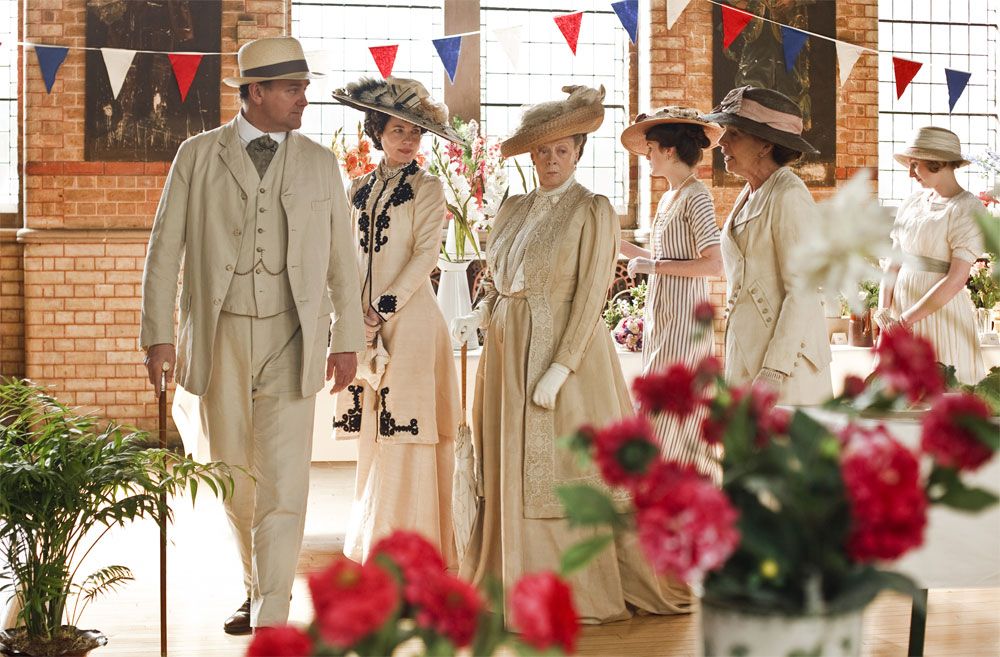
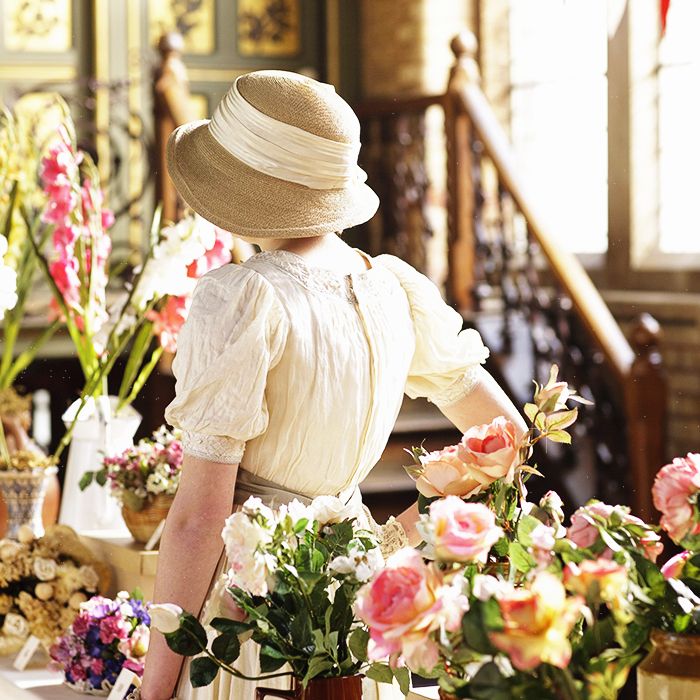
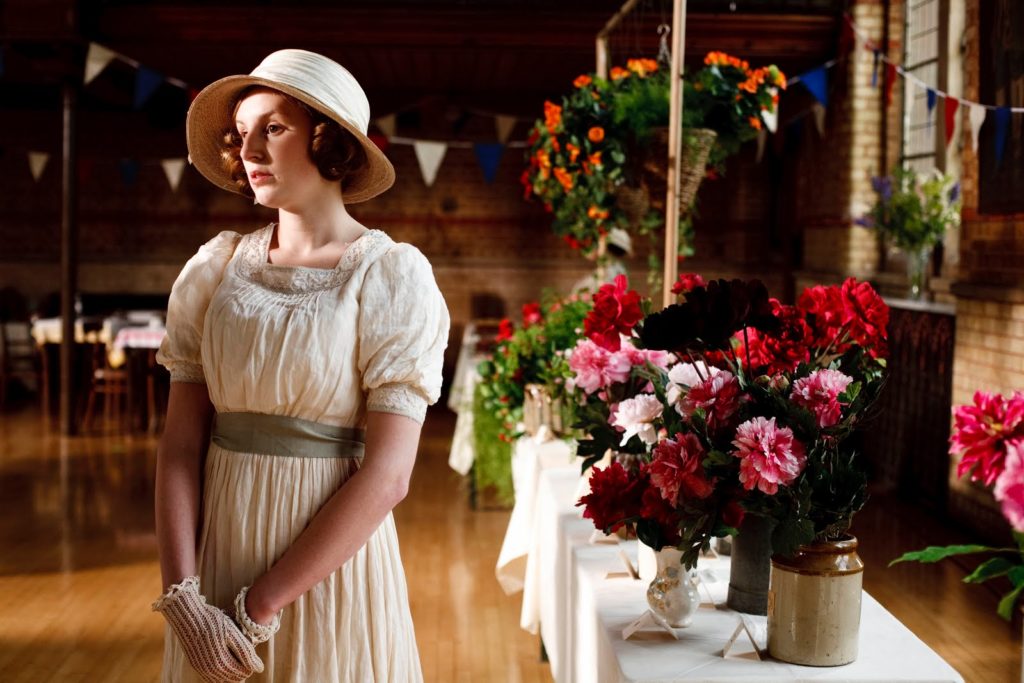
Downton Village Flower Show (Downton Abbey)
Usually organised by the local Horticultural Society, the Parish Council or any other Community association, the Village Flower Shows are generally designed to showcase people’s creativity in different home crafts including gardening. Sometimes they are open to both professional and amateurs, there might be a section for children and there might or might not be money prizes with the glory being only in the wining of the trophies.
It has been traditionally thought that the participants in this type of competitions are elderly allotment holders and retirees with perfect gardens. However, a new breed of young exhibitors is entering their local show as gardening is more popular than ever and television programs such as the BBC’s ‘The Great British Bake-off’ and ‘The Big Allotment Challenge’ have sparked a revived interest in the traditional village show competition and launched successful careers for the winners. To promote this renewed interest in the pleasure of showing the Royal Horticultural Society published in 2017 “Great British Village Show” with tips on exhibiting fruit, vegetables, houseplants, flowers, cakes and chutneys.
From the 1950s to mid-1980s the commercial Flower shows experienced a “Golden Age” with hundreds of professional show exhibitors travelling around the country from April to November. Some of them would participate in up to 60 shows a year and as they would often meet one another at the many different shows, there was a great feeling of camaraderie amongst exhibitors. The whole show circuit resembled a giant, floral travelling circus.
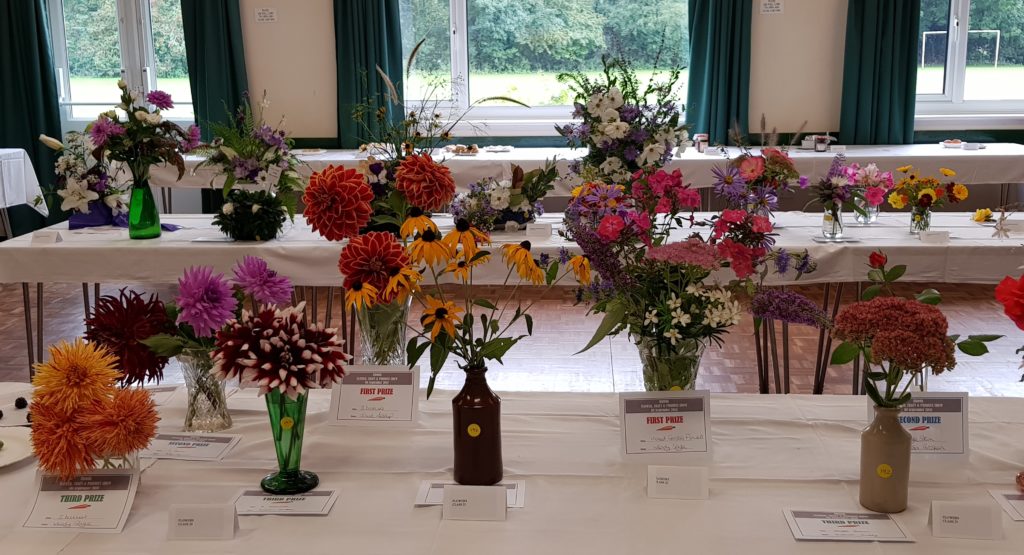
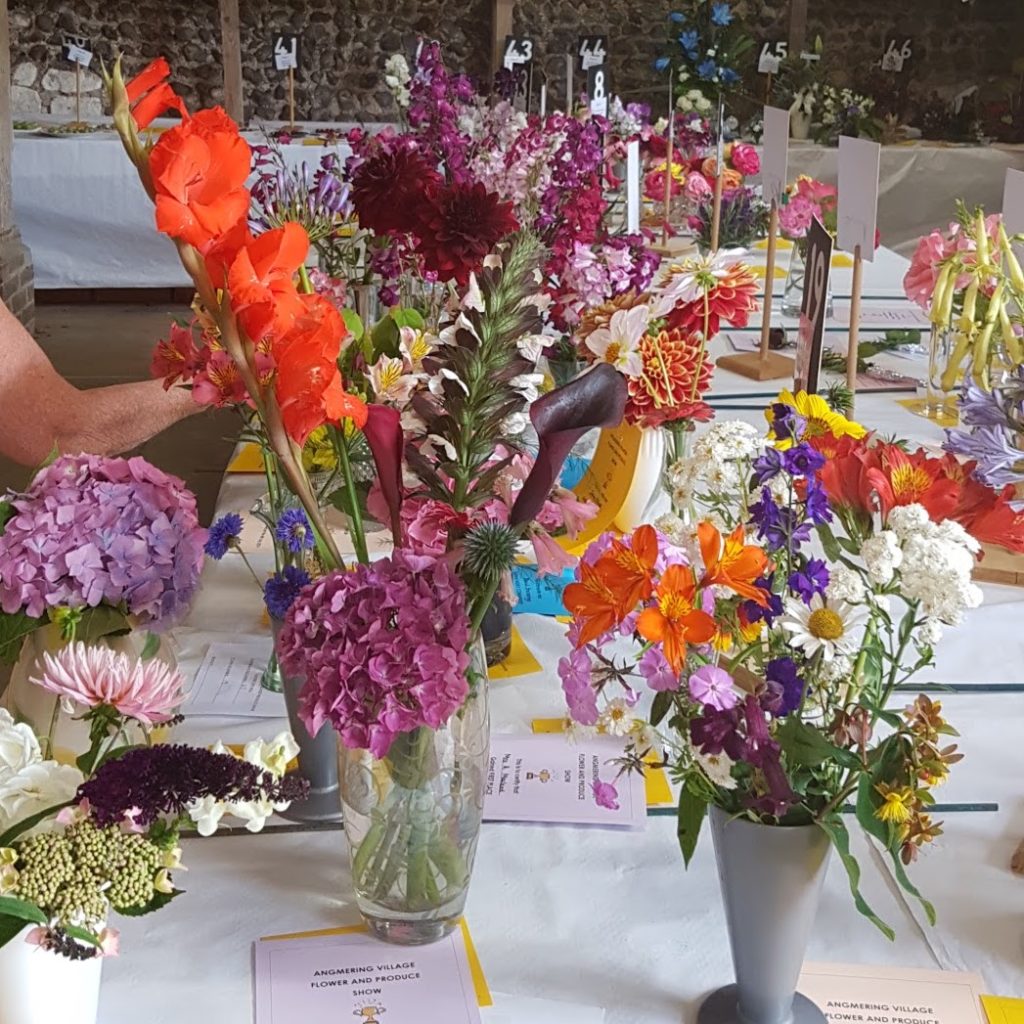

Buriton Village Show
After 1980 there was a huge increase in the number of garden centres, and the big DIY shops also started their own garden sections. Exhibitors at the flower shows started to see a decline in their sales. Also, at about this time, the number of very large flower shows increased, especially those held by the Royal Horticultural Society (RHS). The Chelsea Flower Show has always been the pinnacle of success and the RHS tried to reproduce that. In 1985 they set up the Hampton Court Show, and in 1998 the Tatton Park Show. Some of the county showgrounds also started spring and autumn shows sponsored by the RHS. These shows were successful and could attract 150,000 visitors or more. Many exhibitors found their sales going up at these big shows but experienced a decline at the local county or independent shows. Today the costs for exhibitors to attend the big shows have gone up, and the numbers of visitors attending has gone down, with the exception of Chelsea Flower Show. Many of the smaller shows are struggling to find enough exhibitors and some have closed completely.
But even with those difficulties, spring and summer in Britain are packed with plenty of opportunities, from the world famous RHS Chelsea to the charming lesser-known or local shows that take place up and down the country, to enjoy those enchanting floral and garden displays that have gone to become a truly British tradition. Here is a selection of some of the fabulous shows to visit once we are ready to travel again.
FLOWER SHOWS WITH THE RHS STAMP
The RHS launched their very first show back in 1913 in the grounds of London’s Chelsea Royal Hospital. The show, originally called the ‘Great Spring Show’, was the brainchild of Sir Harry Veitch who identified the hospital grounds as the capital’s most suitable place to showcase the world’s greatest horticultural achievements.
The most celebrated RHS Flower Show
- RHS Chelsea Flower Show
It has gone on to become one of the most celebrated events on the planet and attracts visitors and exhibitors from all nations every year. The RHS Chelsea Flower Show has been such a success for so many years that the RHS decided to launch a number of other events throughout the country, including the renowned RHS Malvern Spring Festival.

Other RHS Flower Shows
- RHS Malvern Spring Festival (Worcestershire)
Set against a backdrop of the magnificent Malvern Hills, it is a spring Festival packed with flowers, food, crafts and family fun. This year you could enjoy Virtual Malvern if you fancy.
With plenty of space to build at Malvern, show garden designers surprise visitors every year with their RHS – medal winning gardens. Shipping containers gardens, creative with scope and planting, offer fresh inspiration for any outdoor area no matter the size.
- Specialist Nurseries Arena; visitors can indulge their inner plants hunter and find rarities in the specialist Nurseries Arena.
- Festival Theatre; inspiring visitors with talks, demos and Q & A sessions.
- Alfresco eateries; explore new tastes and discover new flavours form the best of local food producers and street food.
It usually happens from the 5th until the 9th of May, although this year it has unfortunately been cancelled because of Covid, The Malvern Autumn Festival will be celebrated instead between the 25th and the 26th of September)

- RHS Hampton Court Palace Garden Festival
Celebrate summer at the world’s largest flower show with gardening inspiration and stunning floral displays in a majestic setting. Stretching over 34 acres, it is a celebration of gardening set in the historic grounds of Hampton Court Palace within easy reach of central London.
Visitors can immerse themselves in the inspiration provided by the top things to see:
- Floral Marquee & Plant Village; you can enjoy vibrant flowers of every kind, explore fantastic plant shopping and seek free advice from the specialist growers.
- “The Festival of Roses”; here you can find a favourite new variety of Rose. This is a world of gorgeous colour & scent, as you can imagine. Every year they would name the rose of the year. Sweet Honey “Kormecaso” was named as the 2020 Rose of the Year.

- Global impact gardens; taking global warming as its theme this garden is designed to raise awareness and provoke a response in visitors to take positive action. In this garden you can find a natural idyll appears opposite a burnt and blackened landscape.

The RHS Hampton Court Palace Garden Festival takes place from the 6th until the 11th of July.
- RHS Flower Show Tatton Park (Cheshire)
This northern festival bursts with colourful gardening inspiration, fun family activities, workshops and boutique shopping. Set in the magnificent parklands of Tatton Park, the RHS Flower Show Tatton Park is a spectacular day out.
Renowned for its friendly atmosphere, many of the original features of the show, such as the RHS National Flower Bed Competition, Show Gardens and Floral Marquee remain today. These additions have made Tatton Park a show that relishes fresh ideas and innovation. Community organisations have also played a large part in the show’s identity with charities, schools, local authorities and prisons being involved every year.
The RHS Flower Show Tatton Park is held from the 21st until the 25th of July; this year you can explore at home and look for inspiration to work in horticulture.
- RHS Garden Hyde Hall Flower Show (Essex)
From transforming landscapes and panoramic views to superb ornamental horticulture, the popular Dry Garden and Wild Woodlands, RHS Garden Hyde Hall has inspirational planting for every visitor.
But let´s go back a little bit in history…. In 1955 when Dr and Mrs Robinson came to Hyde Hall there were only six trees on the top of a windswept hill and no garden. If they had known then what they soon learned, it is very doubtful that the garden would have been made!
For centuries Hyde Hall had been a working farm and the area around the house was a dumping ground for all kinds of rubbish. Mrs Robinson started to garden as a reaction against this. In this way she created herbaceous borders and a vegetable garden close to the house and established the framework of the garden with some 60 young trees bought at an auction sale in Wickford Market.
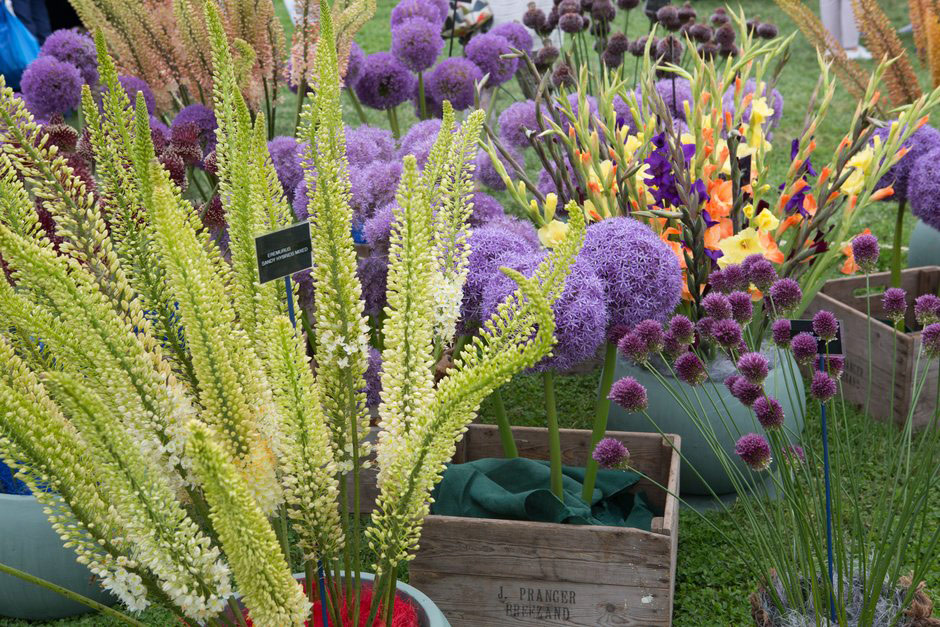
The house, which dates to the 18th century, is a typical Essex farmhouse of timber frame, lath and plaster. At the back of the house Mrs Robinson discovered the Tudor brick floor of an old stable which was excavated to become a natural pavement garden.
Since the Robinsons turned the first spadesful of clay in the 1950s, Hyde Hall has always been a dynamic garden, constantly changing to meet the various challenges the site and soil have produced. The story of the development of this inspiring garden with its extraordinary diversity of plants is a fascinating one, a triumph over conditions that would have daunted less keen and dedicated gardeners.
The Hyde Hall Gardens Trust was set up in 1976 and then in 1993 the garden became the responsibility of the Royal Horticultural Society, having been bequeathed by the Trust to ensure its future survival.
One of the first major garden projects was the installation of a 45-million litre reservoir to provide the garden with all its irrigation needs. To further promote its water-efficient ethos a Mediterranean styled Dry Garden was added to showcase a range of drought tolerant plants. The Dry Garden was completed in the spring of 2001 following one of the wettest winters known.
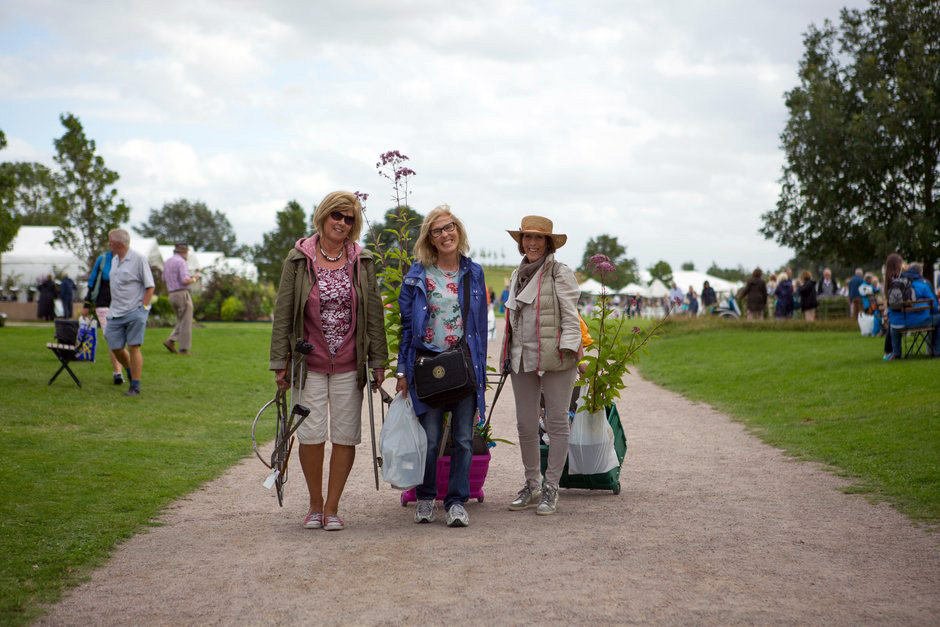
After being cancelled in 2020, RHS Garden Hyde Hall Flower Show returns in August 2021, from the 4th to the 8th.
- RHS Wisley Flower Show (Surrey)
Wisley is a stunning RHS garden and is undoubtedly one of the great gardens of the world. Its huge plant collection is also diverse, with a comprehensive fruit-growing collection, alpines, vegetables, bulbs as well as herbaceous and woody plants.
Taking place in late summer each year, theRHS Wisley Flower Show is home to a plethora of colourful plants, an expert zone with talks and demos and ample opportunities to seek gardening advice. The National Dahlia Society Annual Show regularly forms part of proceedings, showcasing the very best in dahlia cultivation in Britain.
The RHS Wisley Flower is held from the 7th until the 12th of September and brings the show season to a close.
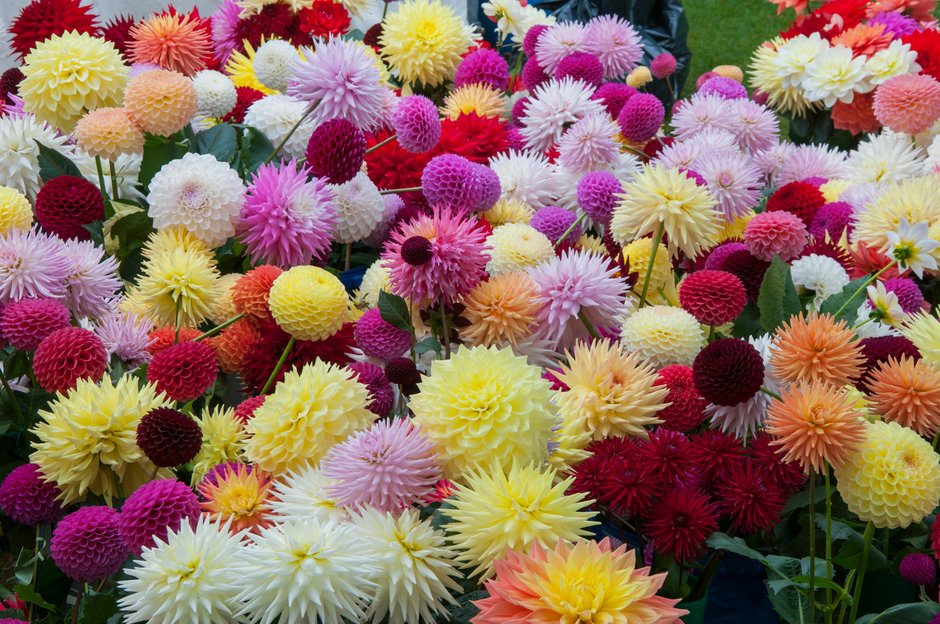
OTHER FLOWERS SHOWS
- Blenheim Palace Flower Show (Woodstock, Oxfordshire)
Not far from London, with over 350 exhibitors present, and located in the scenic grounds of Blenheim Palace, home to the Duke of Marlborough and Winston Churchill, this is a flower show sure to delight enthusiasts of both flowers and historical landscapes.
For three days this summer (25th to 27th of June), Blenheim will celebrate the very best of gardening, home and lifestyle. The 2021 show will include:
- Grand Floral Pavilion showcasing the UK’s finest nurseries and plantsman exhibitors.
- Floral Street – a new feature for 2021 – the perfect street for plants and flowers.
- Shopping Village will feature a variety of trade stands selling everything from unique garden gazebos, greenhouses and arbours to gardening sundries and hundreds of other products
- Food and Drink Pavilion will feature a range of food and drink purveyors and artisans, including tastings and samples.
- Home and Country Living Pavilion filled with a selection of original handmade giftware, jewellery and luxury goods.
- Garden Talks – horticultural experts will be on hand to answer all your gardening and plant questions
- Harrogate Flower Shows (Yorkshire)
The Harrogate Flower Shows are organised by the North of England Horticultural Society (NEHS). There are actually two Harrogate flower shows, one in Spring (20th – 23rd of May) and the other one in Autumn (17th – 19th of September). All profits from the shows are returned to the charity and used to promote gardening and horticulture in the North of England.
The North of England Horticultural Society was inaugurated in the Lord Mayor´s Rooms, Leeds, in 1911. The purpose was to promote horticulture in the North of England, providing a top class showcase for plants and produce grown in the colder northern climate. Help and encouragement was provided in these early stages by the RHS, whose London-based events were then regarded as too far away for northern growers to attend.
Today the Harrogate Autumn Flower Show hosts a range of ‘shows within a show’ and features displays by nearly 20 different specialist gardening groups.
Since their early days as small provincial produce shows, the NEHS Harrogate Flower Shows have grown to become major national events in the gardening calendar. Testament to the shows’ success and popularity is their recent rating among Britain’s top gardening events who ranked the Harrogate Spring Flower Show number one in the country, and the Autumn Flower Show number three.
- Shrewsbury Flower Show (Shropshire)
The present Shropshire Horticultural Society was formally established in October of 1875, just after the first Show. High quality exhibits of Flowers and Horticulture have always been the main focus of the Show as depicted in its name but from the beginning the Show has provided family entertainment.
The Shrewsbury Flower Show is one of the country’s premier flower show events, attracting top exhibitors from all over the country.
- The main Quarry Marquee, which is non-competitive, is host to some of the top horticulturalists in the country.
- The popularity of the Outside Show Gardens grows each year.
- Severn Marquee is home to the various societies, amateur growers plus bees and honey exhibitors. Competition is fierce amongst the amateur growers who provide some wonderful displays.
The Shrewsbury Flower is held for two days on the 13th and 14th of August. Traditionally, a magnificent firework display brings an end to proceedings.
- Chorley Flower Show (Lancashire)
This spectacular event, which scooped a prestigious Lancashire Tourism Award for ‘Tourism Event of the Year’, is the perfect day out for anyone who likes gardening, plants and flowers. Plus, with children’s activities and delicious food and drink, it’s a treat for all the family.
Chorley Flower Show is a two-day event (31st July- 1st August), where you can see and speak to gold-medal winning entrants from some of the country’s biggest shows in the professional exhibitors’ marquee.
You can also take a tour of the historic Astley Hall, which will feature an amazing floral photographic exhibition as well as flower decorations and more.
See the amazing amateur marquee with regional competitions hosted by the National Sweet Pea Society and Rose Society UK.
- Belgravia in Bloom
This festival, which generally coincides with the RHS Chelsea Flower Show, typically sees Belgravia’s independent and esteemed retailers adorning their beautiful boutiques with blooming florals.
Shop fronts, windows and front doors are adorned with elaborate floral arrangements throughout the streets of Belgravia in May.
Belgravia in Bloom sees local businesses and residents come together to create a picturesque spring walk through London, along with installations, standalone displays and other events.
In the past it has been inspired by the Victorian classic ‘The language of Flowers’ and it took place across two venues and featured mood gardens, scent stations & floral workshops and activities. Filled with lavender ‘The Serenity Garden’ aimed to provide a soothing space for visitors to recharge in, while you spotted dogwood flowers on the ceiling of ‘The Tunnel of Resilience’. A canopy of freesias occupied ‘The Canopy of Friendship’ and in the spiral of good luck white walls of Japanese wisteria immersed visitors in the lucky flowers.

- Covent Garden in Bloom
Originally a fruit and vegetable garden belonging to the Westminster Abbey, it became later one of the best fresh food markets in the UK and the birthplace of the most iconic flower sellers in London.
If you’re in this dazzling neighbourhood, immerse yourself in decorative displays as part of Covent Garden in Bloom, which usually sees the return of Fleurs de Villes exhibition at the Central Avenue.
After this journey, that has taken us to review some of the greatest flower shows in Britain, it can be stated that gardening is, without a doubt, a British tradition almost as important as a nice cup of tea. The Royal Horticultural Society (RHS), being the UK’s leading gardening charity, is in charge to promote, support and encourage the celebration of many of the above-mentioned shows so this lovely tradition continues.
If we could try to find in Spain a similar entity or organization, it’s a shame but I could say there is none! Why is it that? Maybe because the passion most British professionals feel is reflected on a different level through the Institutions they support. During the time we lived in London, my experience is that the RHS provides people with places where you can enjoy either a sunny or rainy day, as individual or as families, with the purpose to promote the love for plants, flowers and/or gardening spaces.
ELENA DÍAZ-GÁLVEZ PÉREZ DEL PUERTO
Related link ➡️ Chelsea Flower Show
BIBLIOGRAPHY
- Elliott, B. (2001). Flower Shows in Nineteenth Century England. Garden History, 29(2), 171-184. doi:10.2307/1587369
- Blenheim Palace, published in 2006 by Jarrold Publishing.
- http://www.newforestshow.co.uk/wp-content/uploads/2016/03/Brief-History-of-Flower-Shows-Current-Version.pdf
- https://www.hort.purdue.edu/newcrop/pdfs/ch4801p17.pdf
- https://twitter.com/the_rhs/status/839085976525885442?lang=en
- https://masshort.org/history/
- https://blog.biodiversitylibrary.org/2016/07/the-pennsylvania-horticultural-society.html
- https://www.rhs.org.uk/digital-collections/making-chelsea
- https://www.theguardian.com/news/2014/aug/03/better-days-back-village-flower-show-returns-observer-archive
- https://www.rhs.org.uk/shows-events/
- https://www.blenheimflowershow.co.uk/
- https://www.flowershow.org.uk/
- https://www.visitlondon.com/things-to-do/event/18219357-rhs-chelsea-flower-show
- https://mayfairandbelgravia.com/home/what-s-on/stories/virtual-belgravia-in-bloom
- https://www.countryandtownhouse.co.uk/culture/belgravia-in-bloom/
- https://www.chorleyflowershow.com/
- https://shrewsburyflowershow.org.uk/

